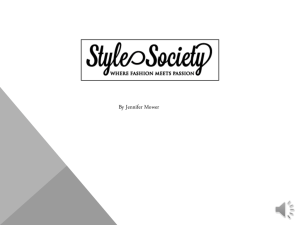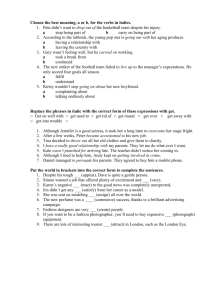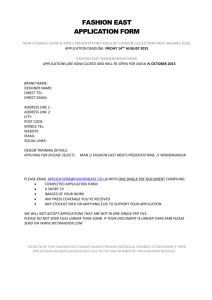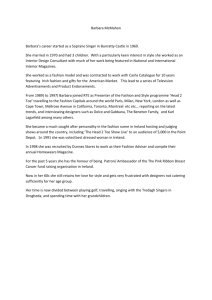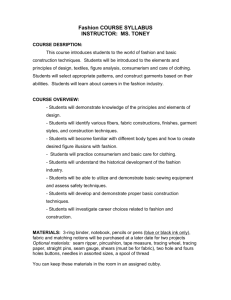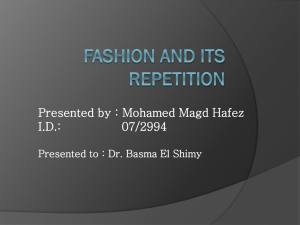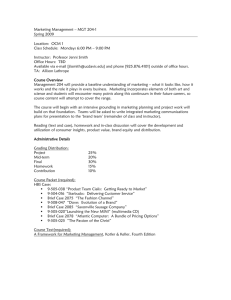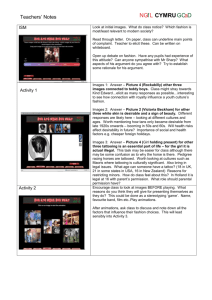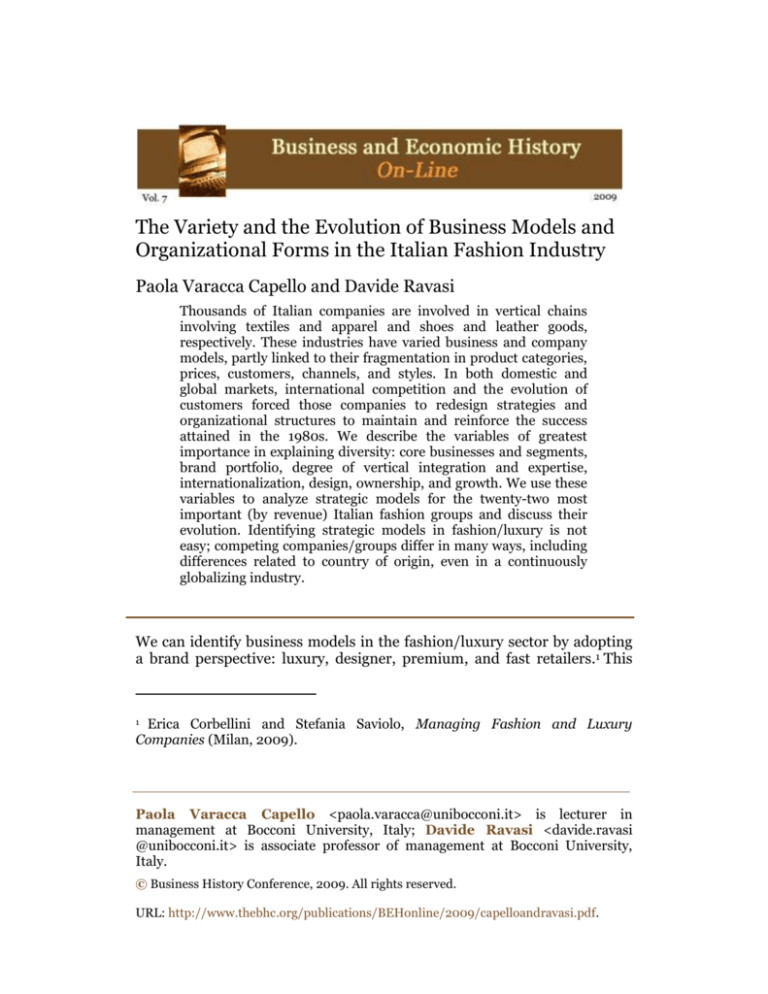
The Variety and the Evolution of Business Models and
Organizational Forms in the Italian Fashion Industry
Paola Varacca Capello and Davide Ravasi
Thousands of Italian companies are involved in vertical chains
involving textiles and apparel and shoes and leather goods,
respectively. These industries have varied business and company
models, partly linked to their fragmentation in product categories,
prices, customers, channels, and styles. In both domestic and
global markets, international competition and the evolution of
customers forced those companies to redesign strategies and
organizational structures to maintain and reinforce the success
attained in the 1980s. We describe the variables of greatest
importance in explaining diversity: core businesses and segments,
brand portfolio, degree of vertical integration and expertise,
internationalization, design, ownership, and growth. We use these
variables to analyze strategic models for the twenty-two most
important (by revenue) Italian fashion groups and discuss their
evolution. Identifying strategic models in fashion/luxury is not
easy; competing companies/groups differ in many ways, including
differences related to country of origin, even in a continuously
globalizing industry.
We can identify business models in the fashion/luxury sector by adopting
a brand perspective: luxury, designer, premium, and fast retailers.1 This
Erica Corbellini and Stefania Saviolo, Managing Fashion and Luxury
Companies (Milan, 2009).
1
Paola Varacca Capello <paola.varacca@unibocconi.it> is lecturer in
management at Bocconi University, Italy; Davide Ravasi <davide.ravasi
@unibocconi.it> is associate professor of management at Bocconi University,
Italy.
© Business History Conference, 2009. All rights reserved.
URL: http://www.thebhc.org/publications/BEHonline/2009/capelloandravasi.pdf.
Paola Varacca Capello and Davide Ravasi // Business Models and
Organizational Forms in the Italian Fashion Industry
2
approach, however, does not capture the variety of fashion/luxury
companies in the emerging and dominant organizational types in Italy and
other important markets.2 In this essay, we aim to outline the variety of
fashion/luxury companies and to detail the evolution and current status of
the most important Italian fashion businesses.
How did Italian fashion/luxury companies evolve during the last thirty
years? What are the most common configurations of strategic and
structural features in fashion/luxury producers? Which growth patterns
are most common? Are particular business models superior in facing the
strong competition in this arena? We focus on the clothing, accessories,
leather goods, and footwear industries, which are directly related to
fashion/luxury dynamics and seasonality.3 We analyze brands that are well
known to the final customer.4
Identifying Business Models in Fashion/Luxury
Taking into consideration all variables that could be used to classify
fashion/luxury groups, we chose to analyze those related to group
structure and corporate strategies: core businesses and core segments;
brand portfolio; degree of vertical integration and core competencies;
internationalization; design; ownership; and growth.
Core businesses and core segments
Today the majority of fashion/luxury groups are present in many
industries: clothing (including all sub-industries, such as sportswear,
underwear, and so forth), shoes, leather goods, eyewear, perfumes,
cosmetics, furniture, home collections, watches and jewelry, and
hotels/restaurants/spas. For this reason they are termed multi-business.
Some large specialized companies (mono-businesses) still remain: they
operate in sub-industries such as underwear, beachwear, and hosiery. It is
not always easy to find information about revenues by product category
See Marie Laure Djelic and Antti Ainamo, ―The Co-evolution of New
Organization Forms in the Fashion Industry: A Historical and Comparative Study
of France, Italy and the USA,‖ Organization Science 10 (Sept.-Oct. 1999): 622-37;
and Diana Crane and Laura Bovone, ―Approaches to Material Culture: The
Sociology of Fashion and Clothing,‖ Poetics 34 (2006): 319-33.
3 For an interesting analysis of different approaches to defining fashion and
luxury concepts, see Corbellini and Saviolo, Managing Fashion and Luxury
Companies.
4 We focus on the twenty-two most important Italian fashion companies listed by
Pambianco in Pambianco Week 8 (14 April 2008): [4-6]. We consider only those
companies that are structured as groups, rather than the entire pipeline: these
companies manage foreign branches, stores, warehouses, laboratories, and
specialized facilities; they buy other companies.
2
Paola Varacca Capello and Davide Ravasi // Business Models and
Organizational Forms in the Italian Fashion Industry
3
(not to mention margins and earnings). When available, however, those
data provide strong signals about the group’s situation; in spite of brand
extensions and brand acquisitions, the core business for fashion and
luxury groups is often that of their original industry.
The same problems arise when considering core segments (for each
business, considering market price-ranges). Information about revenues
per line/collection (different lines/collections are targeted to different
segments) is difficult to achieve; in general what really matters is the
perceived position of the brand. Ferragamo, Gucci, and Tod’s are high-end
examples in the footwear and leather goods industries. For Armani,
Valentino, and Versace, high-end clothing is still their core business.
For fashion groups, the original industries can be clothing, leather
goods, shoes, and accessories, all of which we consider to be related. Those
that differ in the role of creativity, rhythm of innovation and seasonality,
core competencies, and key success factors as connected industries include
cosmetics, eyewear, hotels, and so on.
Brand portfolio
Fashion/luxury groups may be monobrand or multi-brand (even if
product categories and collections are always more than one). Monobrand
situations can refer to ―unique‖ brands, or brands whose brand
endorsements are designed to address specific lines/collections to
different or new consumer targets (maintaining the same imprinting).
Multi-brand groups operate different brands, owned (created internally or
bought) and under license. Licenses can be relevant in the brand portfolio
and are very common in the industry. The case of a ―unique‖ brand is the
rule for luxury products (such as Bulgari, Cartier, Dior, Hermès, and Louis
Vuitton). In fashion, line and brand extensions often result from an
articulation of brands under the same ―family‖ brand (brand endorsement). This is the case for Armani (Armani Privè, GA, A Le Collezioni, EA,
AX, AJ, and Home), Max Mara, and Versace (Versace Uomo e Donna,
Versace Sport, Versace Jeans, Versace Collection).
In general this approach is more common in designer houses (the socalled maisons), where maintaining the signature is crucial. In contrast,
―industrial/retailer‖ groups have often grown in different segments,
creating new ―labels.‖ In the Benetton group, the most important brand is
United Colors of Benetton, followed by 012, Sisley, Playlife, and Killerloop.
Max Mara is an interesting example; where segments are related to the
Max Mara world, we have new labels that hark back to the Max Mara label
(Marella, Max & Co, Sportmax). When the idea is to reach different targets
(and/or to increase the penetration of the market, but avoid mass
distribution), the label is not invoked: Marina Rinaldi, Pennyblack, and
Persona.
The multi-brand group can be classified by considering the number of
brands and the way they have been added (through licenses, internal
creation, or acquisition). The weight of single brands should be con-
Paola Varacca Capello and Davide Ravasi // Business Models and
Organizational Forms in the Italian Fashion Industry
4
sidered. There are not well-defined rules, even for listed companies; we
consider a multi-brand to be a group in which at least three brands each
account for at least 10 percent of total revenue.
The crucial feature is the strategic intent behind the acquisition.
Multi-brand groups are created mainly to acquire know-how (Aeffe bought
Calzaturificio Pollini to gain market share and competency in shoes and
leather goods), to increase market presence with a proposal targeted to
different specific segments (Gucci bought Bottega Veneta and Sergio Rossi
to reach customers in the same high-end segment, but with a different
stylistic identity), and to work on synergies that recognize the need for
financial support (Mariella Burani Fashion Group [MFBG] grew first in
leather goods, acquiring some bridge brands, then grouped and listed
under Antichi Pellettieri, and then repeated this acquisition strategy with
four jewelry brands).
There are situations in which a multi-brand strategy is multilevel: in
2009, Gucci Group (owned by PPR [formerly Pinault-Printemps-Redoute]
group) is a group of eight brands: Gucci (65.3 percent on total revenues),
Bottega Veneta (11.9 percent), YSL (7.8 percent), Alexander McQueen,
Balenciaga, Boucheron, Sergio Rossi, Stella McCartney (together, 15
percent). The same is true of the Mariella Burani Fashion Group.
Degree of vertical integration and competencies
In fashion companies, core competencies are related to the industries and
value chain activities where they operate. The stronger know-how is often
rooted in the business and activities where the companies started:
designer houses were focused on creativity and clothing; industrial
companies on industrializing and manufacturing (and managing
suppliers); retailers in distributing and logistics. All of them have
developed new competencies and learned new businesses, integrating new
activities through time, at different paces. 5 For instance, investment in
retailing (undertaken by virtually all fashion groups) has created the need
for new managerial roles related not only to these new activities, but also
to coordinating them within design, manufacturing, and delivery
processes. For fashion/luxury companies, brand management is a crucial
activity in which all types of groups necessarily invest, even if they take
different approaches. Distribution is related to vertical integration and
know-how. Fashion companies distribute their collections through a mix
of channels, direct and indirect, because markets differ and companies
Celine Abecassis-Moedas, ―Integrating Design and Retail in the Clothing Value
Chain,‖ International Journal of Operations and Production Manage-ment 26,
no. 4 (2006): 412-28.
5
Paola Varacca Capello and Davide Ravasi // Business Models and
Organizational Forms in the Italian Fashion Industry
5
need focused approaches.6 From this point of view, fashion companies are
classified, in general, as wholesale- or retail-oriented, considering the
weights of sales gained through different channels.
Internationalization
Internationalization can obviously be considered from the point of view of
sales, but also includes the international sourcing of raw materials,
manufacturing processes, and finished goods (where fashion company
activities are limited). Although there are common trends, the relative
weights of international sourcing and international sales, the countries in
which they are carried out, and the approaches they take create distinct
differences among fashion companies.
Design
Fashion companies’ long-term success is based on a combination of
stylistic, entrepreneurial, and managerial competencies. 7 All of these
competencies are essential to building and sustaining a long-term
competitive advantage, but not all fashion industry actors possess them
all. Designers are the main source of stylistic competencies; from their
point of view, they have several potential ways to combine their
competencies with those of others.8
To distinguish well-known and emerging designers from younger
ones, as well as internal from external design, we consider the creative
possibilities seen in Table 1. In the designer-owned company, some
renowned designers, whose names are associated with a griffe (signature),
directly control some of the companies that develop their collections (for
example, Armani, Dolce & Gabbana, and Versace). Most of these designers
have found a family member with the complementary competencies
required (for example, Santo Versace).
Some brand-owning industrial companies hire a team of designers (for
example, Max Mara) or rely on freelance designers to sustain the stylistic
For a classification of fashion channels, see Corbellini and Saviolo, Managing
Fashion and Luxury Companies.
7 Pietro Mazzola, ―I processi di industrializzazione della creatività‖ [Processes of
Industrialization of Creativity], in Le imprese basate sulla creatività artistica
[Creativity Based Companies], ed. Santa La Rocca and Pietro Mazzola (Milan,
1991).
8 Davide Ravasi and Paola Varacca Capello, ―Il rapporto stile-industria
nell’abbigliamento formale donna di fascia alta‖ [The Relation between Style and
Commerce in the High-End Formal Womenswear Industry], Economia &
Management 5 (Oct. 2002): 59-75.
6
Paola Varacca Capello and Davide Ravasi // Business Models and
Organizational Forms in the Italian Fashion Industry
6
identity of the brand (or combine the two solutions). Usually, these firms
compete at lower price levels than griffes. Internal teams offer
better
TABLE 1
Options for Creativity
Internal
Well-known
designers
Younger
designers
Maison relying on licensing
(licensor) and designer-owned
company
Art directorship for maison
without the founder designer or
brand-owning industrial company
Brand-owning industrial company
relying on internal design team
External
Brand-owning industrial
company relying on
licenses (licensee)
Brand-owning industrial
company relying on
freelancers
coordination with other functions; the process of product design and
development is under their direct control and it is easier to achieve
coherence with the brand identity. This choice may result in poorer
innovation and poorer contact with the market, however. When there are
freelancers, innovation and flexibility are facilitated, but coordinating
among functions and the control of product design and development
processes can be more difficult. Companies also risk losing their stylistic
identity.
Maisons that have lost their founder designer, as well as other brandowning companies, hire renowned designers as ―art directors‖ (for
example, Gucci and Tom Ford, Chanel and Karl Lagerfeld, Dior and John
Galliano) in order to build or rebuild a distinctive stylistic identity. Thanks
to their creativity, these art directors support the griffe without the
founder designer and/or contribute to the renewal of a brand; however, it
is not always easy to find the right designer.
Many well-known designers rely on licensees, not only to produce, but
also to develop, their collections. In Italy, several large licensees have
played a fundamental role in the success of Italian and foreign designers
such as Armani, Ferré, Gaultier, Moschino, Ozbek, Ungaro, and Valentino.
On start-up, designers acquire a range of competencies and services with
low investments (search and selection of materials, industrialization,
specific manufacturing competencies, management of the selling process,
and market and trade analysis). It is not always easy to launch and
Paola Varacca Capello and Davide Ravasi // Business Models and
Organizational Forms in the Italian Fashion Industry
7
consolidate such partnerships, but they are still frequently used for
growing businesses that require different resources (such as cosmetics,
eyewear, furniture and home collections, and perfumes). Licenses can be
closed, so it is necessary to have a portfolio of brands for companies whose
revenues are strongly dependent on them.
Ownership
Ownership is crucial to strategic objectives. Although Italian fashion
companies are mainly privately owned (by a family, or the family of the
designer or entrepreneur), new owners are appearing on the scene—
namely, private equity funds and multi-brand groups. Families are still
present in these groups, but banks and/or financial institutions own equity
shares. Few Italian groups are listed on the stock exchange, although in
2009 some were ready to go public.9
Growth
The three main mechanisms for growth are acquisitions, internal growth,
and partnerships. Fashion and luxury groups often pursue internal
growth, hiring managers with experience from elsewhere within the
industry to take advantage of their specific know-how; this solution is
often preferred when new businesses are related to the existing ones.
External growth, through acquisitions and partnerships, is preferred when
investing in businesses other than the core business. Partnerships are
created through license agreements and joint ventures, not only for
international outsourcing and distribution, but also to build stronger
relationships in related and connected businesses (see Appendix 1).
The variables discussed here are important in describing fashion
companies in all their variety. Strategic choices in brands and businesses
can be used to describe the evolution of fashion companies; they are more
obvious and there is more information available about them. To analyze
this situation we refer to brands, segments (price ranges), and the origins
of groups.
Pambianco Week, 4 (2008), published the list of the first twenty Italian
companies ready to go public considering brand awareness, growth, EBIDTA,
size, distribution, leverage, age of the entrepreneur, and price positioning. The 20
groups are: Dolce & Gabbana, Only the Brave (Diesel), Liu.Jo, Armani, Prada,
Geo Spirit, Staff International, Ermenegildo Zegna, Pomellato, Max Mara, Loro
Piana, Fashion Box (Replay), Dama (Paul & Shark), Ferragamo, Carpisa, Brioni,
Luisa Spagnoli, Etro, Calzedonia, and Yamamay. At present only Aeffe, Antichi
Pellettieri, Basicnet, Benetton, Csp Int. Ind. Calze (Golden Lady), Geox, IT
Holding, MBFG, Piquadro, Stefanel, and Tod’s are listed on the stock exchange
(excluding textile companies).
9
Paola Varacca Capello and Davide Ravasi // Business Models and
Organizational Forms in the Italian Fashion Industry
8
Italian Companies and Groups in the 1980s and Paths of
Evolution
In the 1980s, three main business models operated in fashion/luxury
industries:
maisons;
industrial companies that were working toward building powerful
brands;
industrial brands growing as licensees for well-known or emerging
designers.
Fashion designers such as Armani, Dolce & Gabbana, Moschino,
Valentino, and Versace were beginning their success stories, which
originated in clothing in the PAP (Prêt-à-Porter/Ready to Wear) segment,
thanks to the presence of industrial companies such as Aeffe, Gruppo
Finanziario Tessile [GFT], and Itierre. These industrial companies were
able to support the development and manufacturing of their collections, as
well as to distribute their products in fast-growing markets in Europe, the
United States, and Japan.
There were also industrial groups working mainly on their own
brands. Some of them originated in the textile industry (for example, Loro
Piana, Marzotto, Miroglio, and Zegna), but quickly entered the clothing
business. Others were growing in the clothing industry, and, in the case of
the largest, creating direct contact with customers through investment in
stores that were either directly managed or franchised (Benetton, Max
Mara, and Stefanel).10
Relevant changes in the late twentieth and early twenty-first centuries
have included brand-extension processes; acquisitions and the birth of
Italian multi-brand, multi-business groups; and vertical integration and
direct control of value chain activities. The first two strategies are
described in Table 2, comparing fashion companies’ options. Becoming
multi-brand has been more urgent for some than for others; they moved
vertically and then undertook brand extension. For other fashion
companies, growth through brand extension has been the stronger driver
(see Appendices 2, 3, and 4).11 Vertical integration has been a common
trend for most fashion companies.
There were also many other smaller companies, trying to build a brand by
focusing on special segments such as underwear (La Perla) and children’s wear
(Simonetta).
11 Giorgio Armani followed a direct path, starting from A, then B, then C. Gucci
started with A and reached, through time, F. Tod’s followed a different strategy,
starting from A, and then D and E.
10
Paola Varacca Capello and Davide Ravasi // Business Models and
Organizational Forms in the Italian Fashion Industry
9
TABLE 2
Fashion Companies’ Evolution
Original Business
(Clothing, LG, Shoes)
One Brand
One Brand n
Endorsed
Brands
New Brand
A: Line extension
new segments
D: Multi-brand
strategy
Related
Businesses
(Clothing, LG, Shoes)
Connected Businesses
(Eyewear, Home,
Fragrances, Jewelry)
B: Brand extension
C: Brand extension
E: E. Multi-brand/Multi- F: Multi-brand/Multibusiness strategy
M
business strategy
Some maisons (once licensors for all lines/collections) have integrated
different activities and businesses. Their main reasons were to acquire the
value and margin of the licensees, control distribution and get closer to the
customers, and prevent ―leaking‖ information about new collections. They
faced problems related to the management of new activities, finding
financial resources, and keeping the level of fixed costs under control.
Industrial groups have maintained the control and management of design,
industrialization and manufacturing, integrating downstream in retail;
brand extension has followed through strong partnerships or acquisitions.
The Situation in the Early Twenty-First Century
The early twenty-first century situation is described in Table 3, which
includes brand portfolio and price segments, together with the origin of
the group, (fashion houses and industrial groups) with manufacturing
(and commercial) background. The multi-business dimension is also
relevant; however, all competitors have brand extensions, even if they
carried them out in different ways, so we highlight the brand dimension
(and exceptions).
In fact, the reality is not so well defined, but single groups should be
recognized in evaluating the weight of different brands (owned and under
license). Many companies offer a wide range of products that should be
located in different price segments. For this reason, and also because
Paola Varacca Capello and Davide Ravasi // Business Models and
Organizational Forms in the Italian Fashion Industry
10
detailed information on revenues is not available, we define two main
competitive arenas: high end and bridge/mass.12
TABLE 3
The 22 Most Important Italian Groups
Brand Portfolio/Price
Segments,
and Origin
Monobrand
Multi-brand
(owned and on license)
Pure fashion houses:
Valentino Fashion Group
HC, PAP, Diffusion,
Designers
Armani, Dolce &
Gabbana, Versace
HC, PAP, Diffusion,
Premium
Ferragamo, Loro
Piana, Zegna
Gucci, Diesel, IT Holding,
Max Mara, Miroglio, Tod’s
Bridge/Mass
Geoxa, Reply
Benetton, Calzedonia,
Golden Lady, Sixtyb
Industry-backed designers:
Aeffe, MBFG, Prada
Source: Pambianco Week 8 (14 April 2008): [4-6].
aStarted 1998.
bStarted 1989.
Luxury brands, in general, compete and generate revenues in product
categories other than clothing; they are vertically integrated in both retail
and manufacturing. 13 They are listed on the stock exchange (Bulgari,
Hermès), privately owned (Chanel), or part of multi-brand–multi-business
groups (LVMH, PPR). Not many Italian brands belong to this category.
Designer groups have developed from small maisons to integrated
groups (Armani, Dolce & Gabbana, Versace); some of them are still relying
on licensing (for example, Cavalli), or they have been acquired by financial
or industrial groups: Ferrè (IT Holding), Moschino (AEFFE), and
Valentino (first by GFT, then by Marzotto, becoming Valentino Fashion
Group [VFG] with Hugo Boss, then PERMIRA). The families of the
In clothing there is worldwide-recognized price segmentation: HC (Haute
Couture), PAP or RTW (Prêt-à-Porter/Ready to Wear), Diffusion, Bridge, and
Mass.
13 Corbellini and Saviolo, Managing Fashion and Luxury Companies.
12
Paola Varacca Capello and Davide Ravasi // Business Models and
Organizational Forms in the Italian Fashion Industry
11
designer-founders manage Aeffe, MBFG, and Prada, but they have, from
the beginning, been industry-backed.
Premium brands are heterogeneous. 14 They have industrial and
commercial know-how. They grew through vertical integration (networks
of different partners, acquisitions, and internal growth). One can see an
evolution: from industrial medium companies (also licensees for
designers) to: monobrand/multi-business (Ferragamo, Loro Piana, Zegna)
and multi-brand/multi-business (Gucci, Diesel, IT Holding, Max Mara,
Miroglio, Tod’s).
Multibrand multi-business groups are profoundly different. Some
have grown mainly through acquisitions of existing companies; for others
the growth was internal, launching new brands. Aeffe, MBFG, and Prada
are not in the designer groups because industrial facilities have been
involved from their beginnings. They have different ownership and
different options with designers.
The mass segment is the fashion retailers’ territory (the most
important are H&M, Inditex-Zara, and Mango). The strategy of these
international competitors can be summarized as follows: deliver new,
fashionable merchandise to large, welcoming stores at a convenient price.
The Italian groups in this segment are slightly different. They operate in
higher price segments (at least when they have more than one brand),
rather than in the general mass market. They have industrial backgrounds
and, in general, are vertically integrated in value chain activities (design,
industrialization, and manufacturing).
Conclusions
In our opinion, the evolution of fashion companies during the last few
decades of the twentieth century has resulted in increased variety. Even
following common paths, companies have differed in pace, intensity, and
the articulation characterizing their strategic choices in vertical
integration, brand extension, and brand acquisition. In addition, in Italy
the multi-brand model is widespread, although there are clear differences
in the number of brands, ownership, and strategies.
There are advantages and disadvantages related to multi-brand–
multi-business groups. The advantages are in financial resources,
management, worldwide distribution and production, experience and
bargaining power with suppliers, distributors, and the media, wellbalanced portfolios of brands (both established and new), different pitches
for the same customer type, and brand-management know-how.
Disadvantages include a lack of managers (because of too many projects),
bargaining power that can be used to reduce costs, but not to get better
14
Ibid.
Paola Varacca Capello and Davide Ravasi // Business Models and
Organizational Forms in the Italian Fashion Industry
12
suppliers, the risk of brand flattening, and difficulties in finding the right
approach for each brand.15
It would be interesting to analyze the financial and economic
performance of all these groups, to evaluate the existence of a superior
model. However, despite the obvious (such as the faster growth of
companies involved in acquisitions and retailing), we think that the lasting
success of fashion/luxury companies is related to a coherent mix of
strategic elements and choices. There are no simple answers; success
cannot be directly related to either a multi-brand or a monobrand model.
Rossella Cappetta, Enzo Perrone, and Anna Ponti, ―Competizione economica e
competizione simbolica nel Fashion System‖ [Economic and Symbolic
Competition in the Fashion System], Economia & Management 2 (March-April
2003): 73-88; Stefania Saviolo, ―Servono alla moda italiana i gruppi
multibusiness e multibrand?‖ [Are Multibrand Multi-Business Groups Necessary
for Italian Fashion?], ibid., 69-72.
15
Paola Varacca Capello and Davide Ravasi // Business Models and
Organizational Forms in the Italian Fashion Industry
13
APPENDIX 1
Ermenegildo Zegna Main Data and Timeline
Ermenegildo Zegna Main Data
Establishment
1910
Revenues 2007
843,000,000€
Brands
Ermenegildo Zegna, ZZegna, Zegna Sport
Licenses
Dunhill, Versace, Gucci, YSL, Tom Ford, Piombo
JV
VeZe (Versace), Trimil (Armani), Zefer (Ferragamo),
Sharmoon
609 Total stores
Distribution 2007
201 owned
384 franchising
24 outlets
Markets
64 countries
Manufacturing
Vertical integration from textile to clothing,
Ownership
Zegna family
Timeline
1889
Michelangelo Zegna starts a little textile business
1910
Ermenegildo Zegna launches the brand and builds the wool
mill (2nd gen.)
1960
Angelo and Aldo Zegna start working (3rd gen.); they start
manufacturing offshore and start PAP man collections
1963
The brand begins to internationalize (Spain)
1968
First Italian production facility (men’s overcoats and
trousers)
1972
Zegna starts the tailoring service
1975
First U.S. shop (NY)
1977
First Asian shop (Tokyo, Japan)
1980
First monobrand store (Paris), followed by Milan (1985)
1990
The 4th generation starts working, expanding into retail
development, and they start brand extension
Paola Varacca Capello and Davide Ravasi // Business Models and
Organizational Forms in the Italian Fashion Industry
14
1999
Zegna acquires Lanerie Agnona (WW)
2000
Ermenegildo Zegna foundation has been set up
1990s-2000s
Brand extension is operated into several categories, such as
leather goods, shoes, fragrances (2003), eyewear (2004licence to De Rigo), underwear (2006-licence to Perofil)
Paola Varacca Capello and Davide Ravasi // Business Models and
Organizational Forms in the Italian Fashion Industry
15
APPENDIX 2
Giorgio Armani Main Data and Timeline
Giorgio Armani Main Data
Establishment 1975
Revenues
2007
1.600 mln/€
Brands
Armani Privé, Giorgio Armani, Armani Collezioni, Emporio
Armani, Armani Jeans, Armani Junior, Armani Exchange,
Armani Casa
Licenses
L’Oreal (cosmetics), Luxottica (eyewear), Dada (kitchens),
Samsung (TV)
JV
EMAAR Hotels & Resorts
Distribution
2007
Monobrand: Giorgio Armani (75), Armani Collezioni (7),
Emporio Armani (150), Armani Jeans (15), Armani Exchange
(71), Armani Casa (17 directly owned; 40 multi-brand)
Markets
WW
Businesses
Apparel, accessories, underwear, swimwear, eyewear, watches,
fragrances, cosmetics, jewelry, home interior
Ownership
100% Giorgio Armani
1975
Timeline
Giorgio Armani and Sergio Galeotti founded Giorgio Armani
S.p.A., ready-to-wear for men and women
1978
Licensing agreement with GFT
1970s
Giorgio Armani launches several lines: Giorgio Armani Black
Label, underwear and swimwear collection, accessories, Armani
Le Collezioni (menswear) and Mani (womenswear) diffusion
lines for United States and Canada
1979
Armani enters the U.S. market
1981
First Armani shop (Milan)
1980s
Emporio Armani and Armani Jeans launched; include
fragrances and eyewear collection
1989
Production integration (Simint SpA)
1991
Armani Exchange brand created
Paola Varacca Capello and Davide Ravasi // Business Models and
Organizational Forms in the Italian Fashion Industry
2000
Armani Home collection launched
2000s
Armani enter the hospitality and real estate industries (with
EMAAR Hotels & Resorts)
16
Paola Varacca Capello and Davide Ravasi // Business Models and
Organizational Forms in the Italian Fashion Industry
17
APPENDIX 3
Gucci Group Main Data and Timeline
Gucci Group Main Data
Establishment 1921
2,175 mln/€
Revenues
2007
Leather Goods 51%; RTW 17%, shoes 15%; watches 4%; jewels
5%; others 8%
Gucci 65%; Bottega Veneta 12%; YSL 8%; other 15%
Brands
Gucci, Boucheron, YSL, Bottega Veneta, Sergio Rossi, Stella
McCartney, Alexander McQueen
Licenses
NA
JV
Zegna
Distribution
2007
560 DOS
Markets
WW
Europe 40%; United States 19%; Japan 16%; Asia 23%; RoW 2%
Businesses
PAP, leather goods, accessories, jewelry, watches
Ownership
PPR group
1921
Timeline
Guccio Gucci opens his first leather goods shop in Florence.
Rome’s shop follows (1938), selling luggage, handbags, gloves,
shoes
1940
Bamboo bag is created
1953
Gucci opens NY store. Guccio dies, his sons manage the
company and expand overseas
1960s
Gucci enters Asian market (Japan, HK) and launches the double
G logo
1972
First cobranded car: AMC Hornet Gucci
1982
Gucci is listed and Maurizio Gucci (3rd generation) became the
leader
Paola Varacca Capello and Davide Ravasi // Business Models and
Organizational Forms in the Italian Fashion Industry
18
Late 1970s1980s
A strong financial (tax evasion) and commercial crisis (mainly
due to a new collection GAC – Gucci Accessories Collection sold
at a low price positioning) leads to the change in the ownership
structure. Gucci is acquired by Investcorp
Early 1990s
Gucci close to the bankruptcy
1994
Turnaround occurs when De Sole (new CEO) and Tom Ford
(creative director) enter the company. Investcorp sells its stakes
(1995)
1999
Gucci acquires Sanofi Beautè, owner of YSL, Sergio Rossi
PPR acquires 40% of Gucci
2000
Gucci buys Boucheron and Alexander McQueen
2001
Signs partnership with Stella McCartney; acquires Bottega
Veneta and Balenciaga
Paola Varacca Capello and Davide Ravasi // Business Models and
Organizational Forms in the Italian Fashion Industry
19
APPENDIX 4
Tod’s Main Data and Timeline
Tod’s Main Data
Establishment
1900
657 Mln/€
Revenues 2007
(53% Tod’s, 30% Hogan, 14% Fay, 2% Roger Vivier, 1% Others)
(65% Shoes, 21% Leather Goods, 14% Others)
Brands
Tod’s, Hogan, Fay
Licenses
Roger Vivier (Roger Vivier is owned by Della Valle family),
Derek Lam
JV
N.A.
Distribution
2007
125 Dos
Markets
WW
Businesses
Apparel, Leather Goods And Accessories, Shoes
Ownership
Diego Della Valle (61%) And Milan Se
1900
62 franchising stores
Timeline
Filippo Della Valle creates a small laboratory for producing
shoes
1970s
Diego Della Valle Enters the Business
1980s
Della Valle Creates Hogan and Fay Brands
1990s
First Tod’s Women Bag Collection; Fay launches
Childrenwear; Hogan starts Childrenwear and Leather Goods
1993
First Fay Women’s collection
2003
Fay Accessories lines launched
2007
Roger Vivier and Derek Lam licenses set up

